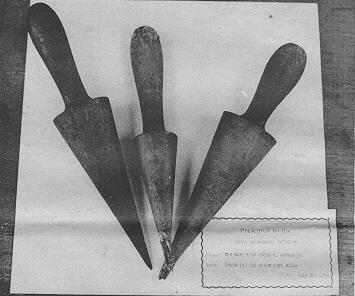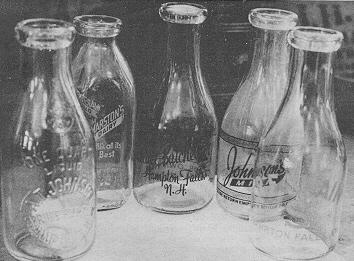By Susan B. Johnson
Public Occurrences
The New Hampshire Seacoast Community
July 26, 1974
Curator John M. Holman, and his wife Connie Holman, executive board member of the Hampton Historical Society, opened the Tuck Memorial Museum doors the other evening, revealing a collection that certainly contains something interesting for everyone.
Like the best kind of small city or town museum, Hampton’s two-room structure houses an array of diverse memorabilia that bears one apparent unifying principle. Everything in the museum relates, in some way, to Hampton. An object may have been made there, or used there, or else donated by a Hampton citizen. And a visit to the Tuck Museum shows just how unrestrictive this governing rule can be.
I had never seen anything quite like the three, triangular wooden objects with rounded handles, resting on a shelf in one corner of a glass display case. But they turned out to have a very specific function, having been made as ice-cream molds, probably in the early part of this century. Perhaps they were used in one of the Hampton’s many dairies. Faced with a collection of fifteen glass milk bottles from different Hampton, North Hampton and Hampton Falls dairies, (of which Runnymede Farms is the only one that still exists), however, makes it impossible for one to guess. Any one of them might have made ice cream.
These bulky, wide-necked bottles make a surprisingly attractive grouping, with the different dairy names and symbols appearing in bright orange, green, red and blue; R. F. Swain — Hampton Falls; A.T. Johnson and Son — Hampton; Badger Farms’ Creameries — Portsmouth; and Wallace Batchelder — Hampton Falls, are just a few of the companies seacoast residents could choose among, for delivery of their milk and dairy products.
Or else, the ice-cream cone molds could have come from Emery’s. ‘S. T. Emery — Homemade confectionary — Corncakes fresh every morning‘, reads a painted wooden sign hanging on one long wall. With its fading painted letters, (white, on a black background), it resembles other painted signs at the museum.
The ‘Police Station‘ sign, for example, is painted in white and black. A sign from the ‘Delancey Express Wagon‘, which carried goods from the railroad station), is lettered in page orange on a blue-green background. A trolley sign that says ‘Portsmouth Car‘ is painted with black letters on a white background, while ‘Special Car‘, another trolley sign, is orange on green.
When the Hampton Town Hall burned on March 19, 1949, its handsome gold lettered sign was confiscated and taken to the town dump. Luckily, John’s father, Marshall Holman saw to it that the sign was salvaged, and it now hangs prominently in the museum.
Not far from this sign, stands the Rival, a cast-iron jigsaw, patented in 1877. This graceful machine balances on curving legs, has attractive foot-shaped pedals, and is decorated with delicate black and gold painting. The Rival made intricate, cut-out designs of wood, (fancy work known as fret-sawing), and although it was manufactured by a company in Seneca Falls, N.Y., an elaborately carved wooden clock at the museum provides ample evidence that it was used in Hampton.
Across the room, on a shelf beside the milk bottle display, is a framed photograph from 1915. Eight Hampton campfire girls, (with their three campfire leaders), pose romantically in Indian fringed dresses, headbands, long braids and beads.
But for old photographs, and postcards, too, one must investigate the far room of the museum, which originally housed the entire museum collection [when the museum was established in 1925]. Here, the Holmans have arranged tables and chairs where visits can sit, poring through huge loose leaf binders packed with Hampton history.
There are pictures of Hampton farms and houses, of families in horse-drawn buggies and early automobiles, and bathers at Hampton Beach. One entire book of photos and news clippings is devoted to the Hampton Beach fire department, while another includes the area’s railroad history, and shows scenes of salt hay collecting on the marshes. (If you have never seen bog shoes, worn by the horses that pulled hay wagons through the marshes, the Tuck Museum has three different kinds on display).
The postcard collection offers a different perspective on Hampton history. Every kind of late 19th and early 20th century picture postcard of Hampton and Hampton Beach is included — providing an exciting and complete document of postcard designs, as well as showing specific Hampton scenes and how they have changed through the years.
As a partial alternative to this kind of random discovery, if one requires it, the Holmans offer a good filmstrip, which highlights area of the collection, as well as furnishing a brief history of the Tuck Memorial Museum and the Hampton Historical Society.




